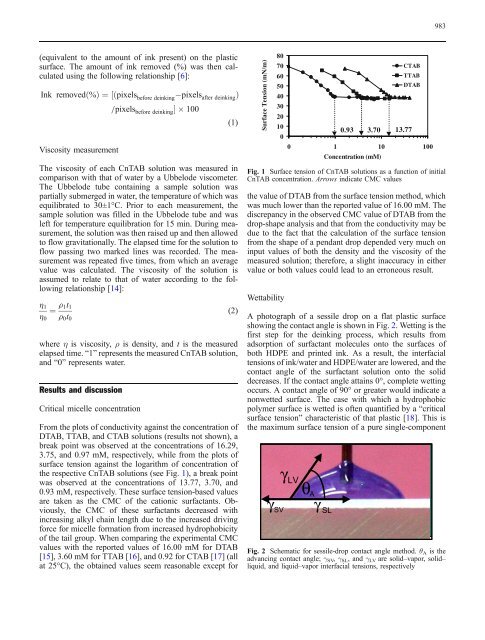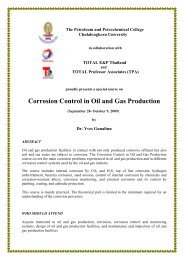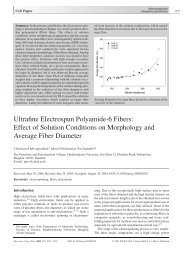Removal of solvent-based ink from printed surface of HDPE bottles ...
Removal of solvent-based ink from printed surface of HDPE bottles ...
Removal of solvent-based ink from printed surface of HDPE bottles ...
Create successful ePaper yourself
Turn your PDF publications into a flip-book with our unique Google optimized e-Paper software.
(equivalent to the amount <strong>of</strong> <strong>ink</strong> present) on the plastic<br />
<strong>surface</strong>. The amount <strong>of</strong> <strong>ink</strong> removed (%) was then calculated<br />
using the following relationship [6]:<br />
Ink removedð%Þ ¼½ðpixelsbefore de<strong>ink</strong>ing pixelsafter de<strong>ink</strong>ingÞ<br />
=pixelsbefore de<strong>ink</strong>ingŠ 100<br />
(1)<br />
Viscosity measurement<br />
The viscosity <strong>of</strong> each CnTAB solution was measured in<br />
comparison with that <strong>of</strong> water by a Ubbelode viscometer.<br />
The Ubbelode tube containing a sample solution was<br />
partially submerged in water, the temperature <strong>of</strong> which was<br />
equilibrated to 30±1°C. Prior to each measurement, the<br />
sample solution was filled in the Ubbelode tube and was<br />
left for temperature equilibration for 15 min. During measurement,<br />
the solution was then raised up and then allowed<br />
to flow gravitationally. The elapsed time for the solution to<br />
flow passing two marked lines was recorded. The measurement<br />
was repeated five times, <strong>from</strong> which an average<br />
value was calculated. The viscosity <strong>of</strong> the solution is<br />
assumed to relate to that <strong>of</strong> water according to the following<br />
relationship [14]:<br />
1<br />
¼<br />
0<br />
1t1<br />
0t0<br />
where η is viscosity, ρ is density, and t is the measured<br />
elapsed time. “1” represents the measured CnTAB solution,<br />
and “0” represents water.<br />
Results and discussion<br />
Critical micelle concentration<br />
From the plots <strong>of</strong> conductivity against the concentration <strong>of</strong><br />
DTAB, TTAB, and CTAB solutions (results not shown), a<br />
break point was observed at the concentrations <strong>of</strong> 16.29,<br />
3.75, and 0.97 mM, respectively, while <strong>from</strong> the plots <strong>of</strong><br />
<strong>surface</strong> tension against the logarithm <strong>of</strong> concentration <strong>of</strong><br />
the respective CnTAB solutions (see Fig. 1), a break point<br />
was observed at the concentrations <strong>of</strong> 13.77, 3.70, and<br />
0.93 mM, respectively. These <strong>surface</strong> tension-<strong>based</strong> values<br />
are taken as the CMC <strong>of</strong> the cationic surfactants. Obviously,<br />
the CMC <strong>of</strong> these surfactants decreased with<br />
increasing alkyl chain length due to the increased driving<br />
force for micelle formation <strong>from</strong> increased hydrophobicity<br />
<strong>of</strong> the tail group. When comparing the experimental CMC<br />
values with the reported values <strong>of</strong> 16.00 mM for DTAB<br />
[15], 3.60 mM for TTAB [16], and 0.92 for CTAB [17] (all<br />
at 25°C), the obtained values seem reasonable except for<br />
(2)<br />
Surface Tension (mN/m)<br />
80<br />
70<br />
60<br />
50<br />
40<br />
30<br />
20<br />
10<br />
0<br />
the value <strong>of</strong> DTAB <strong>from</strong> the <strong>surface</strong> tension method, which<br />
was much lower than the reported value <strong>of</strong> 16.00 mM. The<br />
discrepancy in the observed CMC value <strong>of</strong> DTAB <strong>from</strong> the<br />
drop-shape analysis and that <strong>from</strong> the conductivity may be<br />
due to the fact that the calculation <strong>of</strong> the <strong>surface</strong> tension<br />
<strong>from</strong> the shape <strong>of</strong> a pendant drop depended very much on<br />
input values <strong>of</strong> both the density and the viscosity <strong>of</strong> the<br />
measured solution; therefore, a slight inaccuracy in either<br />
value or both values could lead to an erroneous result.<br />
Wettability<br />
0.93<br />
3.70<br />
CTAB<br />
TTAB<br />
DTAB<br />
13.77<br />
0 1 10 100<br />
Concentration (mM)<br />
Fig. 1 Surface tension <strong>of</strong> CnTAB solutions as a function <strong>of</strong> initial<br />
CnTAB concentration. Arrows indicate CMC values<br />
A photograph <strong>of</strong> a sessile drop on a flat plastic <strong>surface</strong><br />
showing the contact angle is shown in Fig. 2. Wetting is the<br />
first step for the de<strong>ink</strong>ing process, which results <strong>from</strong><br />
adsorption <strong>of</strong> surfactant molecules onto the <strong>surface</strong>s <strong>of</strong><br />
both <strong>HDPE</strong> and <strong>printed</strong> <strong>ink</strong>. As a result, the interfacial<br />
tensions <strong>of</strong> <strong>ink</strong>/water and <strong>HDPE</strong>/water are lowered, and the<br />
contact angle <strong>of</strong> the surfactant solution onto the solid<br />
decreases. If the contact angle attains 0°, complete wetting<br />
occurs. A contact angle <strong>of</strong> 90° or greater would indicate a<br />
nonwetted <strong>surface</strong>. The case with which a hydrophobic<br />
polymer <strong>surface</strong> is wetted is <strong>of</strong>ten quantified by a “critical<br />
<strong>surface</strong> tension” characteristic <strong>of</strong> that plastic [18]. This is<br />
the maximum <strong>surface</strong> tension <strong>of</strong> a pure single-component<br />
γ<br />
LV<br />
θ A<br />
γ γ<br />
SV SL<br />
983<br />
Fig. 2 Schematic for sessile-drop contact angle method. θA is the<br />
advancing contact angle; γSV, γSL, and γLV are solid–vapor, solid–<br />
liquid, and liquid–vapor interfacial tensions, respectively





